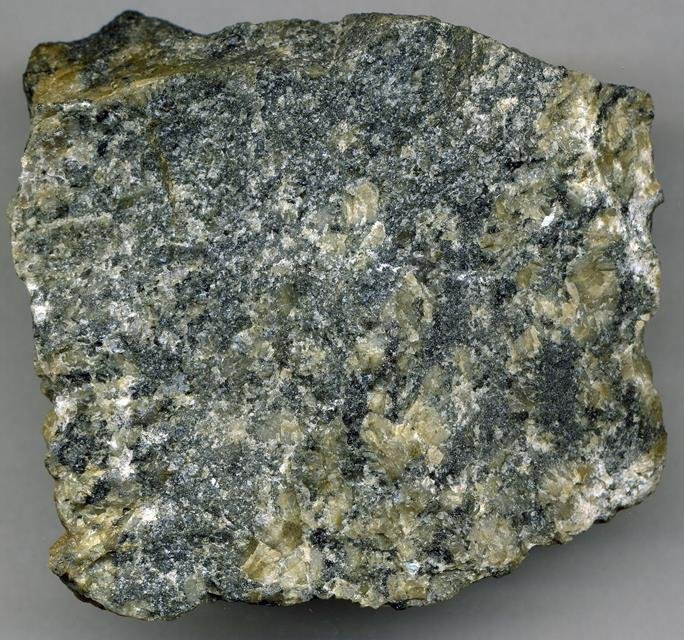Porphyritic diorite rocks have large, well-formed mineral grains of feldspar and sometimes hornblende, pyroxene, or biotite set in a finer-grained but phaneritic matrix.
The groundmass has mostly plagioclase, some augite pyroxene, and a small hornblende. Also, it can contain muscovite, quartz, biotite, alkali feldspar, and accessory minerals.
The larger, well-formed, or euhedral minerals are called phenocrysts, while the matrix is groundmass.
In diorites, sodic plagioclase is usually andesine. However, it can vary from anorthite to oligoclase, while the pyroxenes can be clinopyroxenes like augite, pigeonite, and enstatite orthopyroxene.
Sometimes, diorite rocks with porphyritic texture are known as diorite porphyry. Porphyry (or phyre in the US) is a noun, while porphyritic (or phyric in the US) is an adjective that describes rocks with bimodal grain size.
Lastly, the porphyritic texture isn’t so common in diorites as its extrusive equivalent, andesite.

How do porphyritic diorite form?
Porphyritic diorite likely forms when some minerals crystallize earlier outside the eutectic composition or when rocks have different mineral rates.
Eutectic composition is a homogenous mixture whose melting point is lower than that of any of the components that make it.
Two-stage cooling isn’t likely to form this texture because this is a plutonic rock. It forms deep inside the Earth’s crust, where cooling occurs slowly at a nearly constant rate.
Crystallization outside eutectic composition occurs when some minerals with a higher melting point crystallize earlier. This allows them to grow large crystals, which will form phenocrysts.
These phenocrysts are well formed because they grow inside a mostly liquid magma with little restriction.
Minerals in the finer-grained groundmass crystallize at an eutectic composition, forming the matrix. The texture is coarse-grained since cooling is slow.
On the other hand, crystal size depends on nucleation and crystal growth rate. Phenocrysts can form from minerals that nucleate less but whose crystals grow fast.
In contrast, the groundmass will have mostly more nucleating, slower-growing minerals.
Orbicular diorite?
Sometimes, porphyritic diorite may have an orbicular texture like the one found on Corsica Island in France.
The orbicular texture will have large ovoid or spheroidal structures with concentric rings or shells of alternating texture or mineral composition that emanate from a central point.
These structures aren’t part of diorite porphyry but can occur together on the same rocks.
Uses of diorite porphyry
Porphyritic diorite uses are the same as of aphyric or non-porphyritic rock. You can use them as construction aggregate for the roading industry, railroad ballast, fill material, or on unpaved walkways, pathways, or patios.
They also make good-dimensional stones for construction, such as tiles, pavers, monuments, sculptures, etc.
Lastly, some quartz-diorite to quartz monzonite may host porphyry copper deposits. Some of these deposits also have pyrite, an iron ore.
Where do they occur?
Porphyritic diorite occurs on volcanic arcs above subduction zones and orogenic belts. They exist as dikes and sills and are sometimes part of granitic batholiths.
The Henry Mountains in Utah, USA, has porphyritic dioritic laccolith, while Coos County in New Hampshire has hornblende diorite porphyry.
What is diorite?
Diorite is a coarse-grained, medium to dark-gray intermediate plutonic rock. It has 52-63 wt.% silica and is moderate in iron, magnesium, sodium, and potassium oxides.
This rock has mostly sodic plagioclase and a small amount of hornblende and biotite minerals. However, it may have a tiny amount of alkali feldspar, olivine, pyroxene, and accessory minerals like zircon, titanite, apatite, and sulfides.
